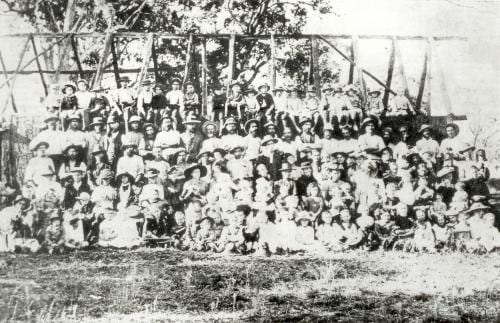Source: Hoch, Isabel. 2008. Pages 25, 37, 39, 71, 93
In June 1891 about 70 unionists, aged 18 to 63, settled at the shearers’ camp near the Alice River and attempted to establish a market garden, a scheme backed by William Campbell and other businessmen. They were English, Irish, Scottish, German, one each Danish, Indian and Welsh, and from five different Australian states. Under J. Pennington, Director of Works, they used an old sheep yard for a garden and set up a trust for all donations.
The Alice River Co-operative Settlement was given government approval with tools and seeds promised and the settlers so hopeful and enthusiastic that they encouraged about 100 old men to remain in a camp nearby. They were given food in exchange for light duties instead of going to Dunwich – a bleak asylum on Stradbroke Island to which derelicts were usually sent, but most of them must have drifted away because no further mention of them appeared in the newspaper.
Within two months at the Alice they’d laid out a township of slab and bark huts with streets named Freedom, Union and Nil Desperandum and they cleared and fenced 25 acres which they planned to irrigate from a well on the river bank. When the premier, Sir Samuel Griffith, visited the site he arranged for an old Tangye pump from the railway to be presented to the settlement and the Department of Agriculture sent 100 grape cuttings. Unfortunately the season turned dry and by October the grape cuttings were all dead, cabbage and bean crops ruined. The settlers battled on and by March 1892 they had drayloads of melons for sale in the town. They constructed a stone dairy after a gift of cows from J. Niall of Delta and established a new vineyard, installed bee hived, and made a communal dwelling with timber donated by J. Lloyd-Jones and E.U. Patterson.
It was well supported by the community and founded on high ideals, which included the intention to work for the first year for a share of improvements, and keep, but no money drawn from the fund.
Five square miles for the Co-operative were gazetted in June 1892 at an annual rental of £1 per acre but even with so much help the scheme eventually failed. In March 1893 twenty men left in one week and after a few years only a handful remained. The seasons were too unreliable and market prices in the west were undercut by the hard working and ever resilient Chinese.
The Co-operative formed into Barcaldine Farming and Grazing Company in 1907 when only three original settlers were left (Evans, Atthews and Quantril). Younger men, Carmody and Searle, brought in some capital and new ideas and Quantril, who sold out his share in 1914, was said to have ‘gathered a comfortable competence’ on which to retire when he went back to Kent in England.
In 1934, to help the district, local MLA Frank Bulcock, persuaded the State Government to establish a new industry – a plantation of date palms at the site of the old Alice River Co-operative Settlement. The palms did well and were still thriving in 1985; but finding a profitable market, and harvesting the dates before fire or birds destroyed them proved impossible. A bird sanctuaty established there in 1938 did little to help. In 1945 Barcaldine Council was asked to take over the date farm.

